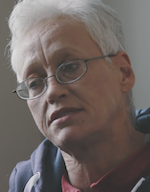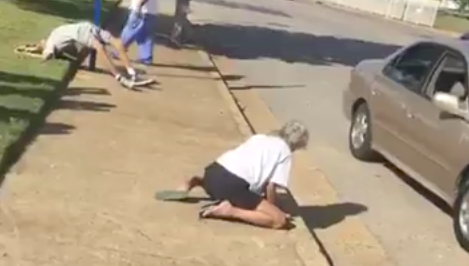The couple had taken a dose of heroin in the bathroom of a drugstore, then decided to try to make it to the bus. Before it could arrive, they both began overdosing and collapsed. Ron Hiers was sprawled backward on a bus bench, his wife, Carla, nearby on her knees with her face planted on the sidewalk.
Then the moment came that actually saved their lives, but they couldn’t immediately know it. A man began streaming the scene on Facebook as it happened on Oct. 3, 2016. At various points, you can hear him laughing.
They were eventually revived with naloxone, and the video went on to gather millions views.
Days after the overdose, Memphis station WREG-TV put together a story about the overdose and the video, which was seen by Ron Hiers’ estranged daughter, Paris Hardee. She called a hotline to a rehab center called Turning Point that had been featured at the end of the piece, setting in motion the rehabilitation that the couple so desperately needed.
Flash forward a year later, and now we’re about to find out exactly how that incident became one of the most vivid scenes in the nation’s opioid crisis. TIME and Mic have teamed up for a 20-minute documentary and an accompanying story that follows the couple’s journey as they try to shake years-long addiction. Here's the link to their package.
Poynter wanted to get some insight into how this project came to be and what hurdles the journalists and producers might have encountered in the process. Here’s our email conversation, which has been edited for length.
First, since this is a collaboration, how did you decide to work together? Have you done other collaborations before?
Ben Goldberger, Assistant Managing Editor, TIME: We feel like the opioid epidemic is one of the most important stories of our time, touching all corners of the country and virtually every segment of society. Collaborating with Mic was an opportunity to combine forces and increase both our man- and brain-power to better tackle it. We've collaborated with other organizations before, including a recent investigation into faulty hospice care with Kaiser Health News, as well as with other brands inside Time Inc. This felt like a natural extension of that work, on a particularly important topic.
How long did you work on this project?
Paul Moakley, Deputy Director of Photography and Visual Enterprise, TIME: We began working on it over a year ago when the video of Ron and Carla first surfaced. We had been interested in looking at viral photographs and videos of people overdosing in public, and wanted to investigate the phenomena. The first story that sparked this was the image from East Liverpool, Ohio, of the boy in the car. Here’s the story I produced around it. The original team that helped shape the direction of the project included senior writer Alice Park, assistant managing editor Ben Goldberger and deputy editor Kira Pollack at TIME and Kerry Lauerman and Aja Harris, my co-producer, at Mic. Then we had the chance to team up with Mic and created a team of eight people that worked on this.
Mic Executive News Editor, Kerry Lauerman: We first started discussing ideas in January. Both TIME and Mic have been separately discussing ways to cover the opioid crisis, and were both captivated by the rash of videos and photos — some released by the police — showing people apparently overdosed on opiates. We all seemed to be curious about what that very public shaming experience would be like, but more urgently, we wanted to know how those people were now.
Obviously, Ron and Carla's story was a very public one. What prompted you to decide to document their life after that horrible moment at the bus stop? Describe what brought you to them. Did Ron's decision to share his story with CNN a month after the overdose play into it?
Moakley: The video of Ron and Carla is so complicated and it can be analyzed through so many lenses, but at TIME we’re always interested in the human side of stories and are encouraged to investigate huge issues, like the opioid crisis, through deep dives into people’s lives. This is an approach to journalism that has always felt natural to me. When I hear numbers, I always want to see the people behind them. When we saw the CNN video, we felt like the story could go much deeper and that’s naturally a better fit for TIME. We were also really curious to know what happened to Carla and why she wasn’t talking to anyone. The part of the video that breaks my heart the most is seeing her face on the ground. It’s a devastating moment that Ron articulates best as her husband. I left a message for the communications director at Addiction Campuses and he called me back saying, “The only reason I called you back is because you said you wanted to do a story on ‘recovery.’ You were the only person who did not just want to focus on the video.” Then he heard me out on the phone and felt like we’ve treated Carla carefully and sensitively. In all of the stories around viral videos and photos we wanted to make sure we started to hear voices of the subjects and give them a platform to really tell us how this happened to them.
Getting Ron's daughter to participate seems like a key piece of the reporting and serves as one of the emotional underpinnings of the story. How difficult was it to get her to go on camera? Were there any ground rules that you needed to establish?
Moakley: Paris was very cautious about doing the interview and required multiple deep conversations about the intent of the story. As a team, with Mic’s Aja Harris and TIME’s Alice Park, we all convinced her that we would work closely with her throughout every step of the process. Earning a subject's trust is always a critical part of any immersive reporting project.

Carla also seems like she would have been a hard subject to interview. What was it like dealing with her? Even though she was part of that spectacle that day, her story seems very secondary to Ron's. Were you disappointed in that?
Moakley: Carla is a very different subject from Ron. He’s a natural storyteller, performative and is comfortable talking for hours on camera. Carla is much more tentative, shy and it was her first time talking to any press about that moment. It was difficult for her to open up in front of the camera and she didn’t want to open up about certain details of her life when we started. Even though she’s not in the film as much as Ron, I think her statements have a different weight and she’s come to recognize some incredibly beautiful things about herself since she’s been in recovery.
Filming in a rehab center has to be very difficult to get everyone to agree to the cameras. Was it worth it to get those scenes of Ron speaking to the other addicts?
Moakley: It is difficult and we wanted to be incredibly sensitive to everyone in treatment. Addiction Campuses was incredibly helpful in that regard. I think the group shots humanize the film even further because you get to see so many different kinds of people dealing with the same thing. In covering the opioid crisis I’ve heard so many addicts describe the stigma formed around their addiction and how it isolates them from everything. We hope we can move people to be more open, caring and understanding about what addicts are all going through. If we filmed blurry people or pixilated them It would just feel cold and uncaring. We’re deeply grateful for these groups for being so brave.

Putting on my critic's hat just a bit here. You show the overdose video of the couple in the beginning to set the scene for the piece. But then you come back to the video clip again several minutes in and it seems to me that you show it in its entirety again. Tell me a bit about that. Why replay that humiliating scene over again at such length?
Moakley: The original Facebook live video is over 22 minutes long and IS gut wrenching to watch. We were all really concerned about how much we show it and we tried to balance it as thoughtfully as possible throughout the film.
Lauerman: We tried hard to be judicious in how much of the video we showed, but also felt it was really important to come back to it as both Ron and Carla react to and describe it at different times in the documentary. We thought it was really important to not shy away from just how graphic that video is. It was powerful to them, too — and very much compelled both of them into treatment.
Who do you hope is the audience for this documentary? What are you trying to tell them?
Moakley: We hope it shows addicts and their loved ones that no matter how long you’ve been addicted, whether it’s one year or more than 40 years like Ron, you can turn your life around. I know a lot of people out there that have been affected by the crisis, including my own family, and I hope that it finds a wide audience.
Lauerman: You can't underestimate the millions of people who have watched those viral videos or read stories about the emerging population struggling with opioid addiction and yet don't really understand what it really entails. The hope is that a portrait like this does what journalism should do: Explain an important story, in a powerful way, to people who otherwise just don't get it.
In a way, this is a hopeful story, but is it a realistic story? Do you worry that you're telling the story too soon? Will you be following up from time to time to see if Ron and Carla really do make it out alive?
Moakley: We think it is a hopeful story in a lot of ways but we were very mindful of not making them seem like heroes. We also wanted to be clear about how much support Addiction Campus gave them. Most people in their situation are not provided any help, let alone this degree of care. I think Paris expresses how tentative she is about all of this change, too, and is still keeping her boundaries up. But we also know that each of them have found great support systems, and were mindful of this concern throughout. That's one reason we chose to wait for over a year to release the project. Ron and Carla have worked hard for over a year to be clean after a lifetime of addiction and that needs to be recognized. No one can predict what will happen to them but we wish them the best.
What were the main hurdles you had in producing this piece? If someone wanted to do a similar video in their coverage of the opioid epidemic, what would you advise?
Moakley: The most difficult part was waiting for Carla to be ready. My advice would be to just be sensitive and empathetic to the people who are most vulnerable.
What's up next on this topic? What are some other ways video can help tell this story?
Moakley: TIME is committed to continue covering the opioid crisis, on video, in the magazine and across our many other platforms. And a critical part of that story is recovery. We think it’s vital to turn the conversation surrounding the opioid crisis toward education and stories of recovery, to show that there is hope amid the despair. Do look for more from me and my colleagues at TIME in the coming year.






